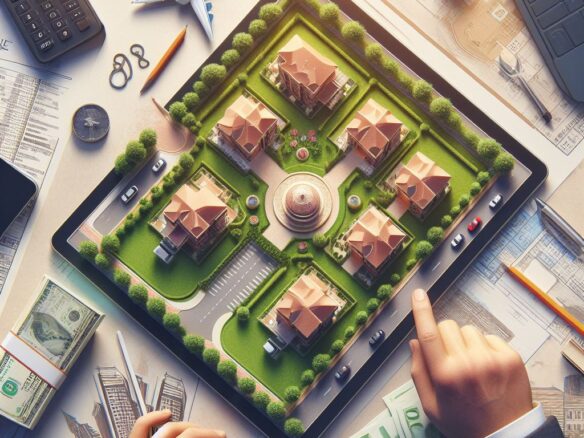Explore the landscape of Pakistan’s real estate market in 2024, where economic, technological, and consumer-driven shifts are ushering in a new era of opportunities and challenges. This article delves into the market’s value and substantial contribution to Pakistan’s GDP and economy, accounting for about 2% of the GDP and engaging approximately 7% of the labor force.
As we navigate through government reforms, infrastructure development, housing demand, and foreign investment, it becomes evident that Pakistan’s real estate market is poised for transformation. Divided into residential, commercial, and agricultural segments, the market presents diverse prospects for real estate professionals and investors. Join us as we unravel the major themes and advancements shaping the future of Pakistan’s real estate market in 2024.
Historical background 2023
Amidst political and economic instability, Pakistan’s real estate market faced unprecedented challenges in 2023. The depreciation of the Pakistani Rupee and soaring inflation led to a downturn, particularly impacting plots and files in the sector. Even construction witnessed reduced activity, reflecting the tough economic climate. This followed a turbulent 2022, marked by significant governmental policy changes aiming to redirect investments away from traditional avenues like plots.
While Punjab’s real estate market experienced volatility, Islamabad and Karachi remained relatively stable. Despite rumors of Bahria Karachi’s bankruptcy, Karachi’s market held steady. Similarly, Islamabad’s construction projects thrived, maintaining stability despite the overall turmoil.
Pakistan’s real estate sector saw a significant loss of investor interest during this period, with many capital and investments diverting towards the booming Dubai real estate market. Pakistan ranked as the 6th largest nationality investing in Dubai’s property market since 2022.
Table of Contents
THE FUTURE OF THE REAL ESTATE MARKET
In Pakistan, real estate demand hinges on factors such as population growth, urbanization, income expansion, remittances, and low interest rates. Estimates from Graana.com reveal a significant housing demand of around 10 million units, with a noticeable supply gap of 4.5 million units. Moreover, the commercial property sector is witnessing a surge in demand with the expansion and entry of more businesses into the market. Land availability, construction costs, regulatory frameworks, and security conditions shape the supply dynamics. These elements collectively influence the equilibrium of the real estate market in Pakistan.
Despite facing obstacles, Pakistan’s real estate market holds immense potential for growth and enhancement, poised to contribute significantly to the nation’s economic and social advancement. As per a Statistic report, projections indicate a robust trajectory, with the real estate market’s value anticipated to soar to US$2.11 trillion by 2024 and US$2.77 trillion by 2028, boasting a compound annual growth rate (CAGR) of 7.04%. Notably, the residential segment is set to lead the market, with an estimated value of US$1.49 trillion in 2024 and US$2.02 trillion in 2028. These forecasts underscore the promising outlook and lucrative opportunities in Pakistan’s real estate sector.
Pakistan’s 1st online real estate marketplace, the real estate sector accounts for about 2% of the country’s GDP and employs about 7% of the labor workforce. The sector is divided into three main segments:
Residential: The residential segment includes houses, flats, apartments, and plots for living purposes.
Commercial: The commercial segment includes offices, shops, malls, and other business spaces.
Agricultural: The agricultural segment includes farms, orchards, and other land for cultivation.
THE FUTURE OF THE RESIDENCE REAL ESTATE MARKET
Pakistan’s residential real estate market has experienced significant expansion and change in the last few years, driven by the country’s growing population and proactive government initiatives. Emerging trends and revolutionary developments characterize this dynamic landscape, which presents many opportunities for stakeholders and investors.
- Customers’ demand for modern amenities and prime locations is driving significant growth in Pakistan’s residential real estate market.
- To improve their lifestyle, buyers are increasingly looking for properties with amenities like fitness centers, gated communities, swimming pools, and round-the-clock security.
- In order to meet the demand in large cities with limited land, the market observes an increase in the construction of high-rise buildings and housing societies.
- Increasing population growth and urbanization also contribute to the market’s expansion, drawing in both domestic and international investors.
- Government policies and favorable economic conditions increase the sector’s appeal to investors.
- Forecasts show significant growth, with the market predicted to maintain an 8.70% CAGR and reach US$1.49 trillion by 2024 and possibly US$2.08 trillion by 2028.
- With an estimated value of US$117.40 trillion by 2024, China, in contrast, is expected to lead the global residential real estate market, demonstrating its significant global impact.
- Pakistan has a notable demand for high-rise apartments because of the country’s growing urban population and scarcity of available land.
Among these encouraging developments, Pakistan’s real estate market is full of opportunities.
Looking for a property Click here!
THE FUTURE OF THE COMMERCIAL REAL ESTATE MARKET
Customer preferences: In the Commercial Real Estate market in Pakistan Customers are looking for modern and well-equipped office spaces that are easily accessible and have good infrastructure.
Local circumstances: Pakistan’s youthful and expanding population is fueling the demand for commercial real estate, driven by a surge in young professionals and burgeoning entrepreneurs. Government initiatives promoting foreign investment, including tax incentives and business-friendly reforms, have attracted increased international interest in the Commercial Real Estate sector, stimulating further growth and development.
Trends in the market: In the Commercial Real Estate sector of Pakistan, co-working spaces are on the rise, meeting the needs of a growing number of startups and freelancers for flexible, budget-friendly office solutions. Additionally, mixed-use properties are gaining traction, blending residential, commercial, and retail spaces to foster vibrant, integrated communities. This trend is especially prevalent in urban hubs like Karachi and Lahore, catering to the desire for seamless living, working, and shopping experiences.
Underlying macroeconomic factors: Pakistan’s youthful population fuels the demand for commercial real estate as young professionals and entrepreneurs enter the workforce. Government policies promoting foreign investment, such as tax incentives and business reforms, drive growth in the sector.
The Commercial Real Estate market in Pakistan is shaped by macroeconomic factors like GDP growth, inflation, and interest rates. Stable political and security conditions attract investors, while customer preferences for modern spaces and government policies promoting foreign investment drive growth and development.
The Commercial Real Estate market in Pakistan is poised for significant growth, projected to reach US$0.61 trillion by 2024 with an annual growth rate of 3.13%. Fueled by the nation’s expanding economy and rising foreign investment, demand is surging in this sector.”
THE FUTURE OF THE AGRICULTURE REAL ESTATE MARKET
Pakistan’s diverse landscapes and agricultural potential offer a unique canvas for real estate developers to create sustainable and integrated projects that combine agriculture and rural development. we will delve into in-depth case studies of successful real estate ventures in Pakistan that have effectively merged agriculture with rural development.
Bahria Town, Karachi: Orchards of Opulence
Bahria Town Karachi blends luxury living with agriculture, featuring fruit orchards within residential neighborhoods. These orchards not only enhance aesthetics but also promote environmental conservation, offering residents access to fresh produce. Sustainable landscaping practices further contribute to environmental preservation.
DHA City, Lahore: A Vision of Green Living
DHA City Lahore seamlessly integrates agriculture with modern living, featuring vast green spaces and dedicated agricultural land. Urban planning prioritizes greenery, enhancing quality of life, and fostering community engagement through sustainable farming practices.
Ravi City, Lahore: The Agro-Economic Hub
Ravi City Lahore, an ambitious project, aims to revitalize the agricultural sector with modern infrastructure and efficient irrigation systems. Promoting advanced farming techniques boosts productivity and stimulates economic growth in rural areas, turning underutilized land into a thriving agro-economic hub.
Gwadar Golf City, Balochistan
Gwadar Golf City in Balochistan seamlessly merges tourism and agriculture along the Arabian Sea coast. Featuring golf courses, luxury resorts, and scenic landscapes, this project integrates agricultural pursuits, offering a unique blend of leisure and farming experiences. Mixing agriculture and tourism diversifies income, reduces risks, and offers unique opportunities in coastal regions for real estate development.
Advantages of investing in agricultural land in Pakistan
- Owning agricultural land offers stability as the industry often rebounds from economic downturns.
- it serves as a hedge against inflation, with land values and commodity prices typically rising in tandem with inflation rates.
- Landowners enjoy financial security with a constant demand for agricultural products, as food production remains essential regardless of economic fluctuations.
- leasing land to tenant farmers provides a reliable source of rental income, particularly during challenging economic periods.
- Take advantage of tax benefits and government incentives to support the agricultural sector, enhancing the financial viability of owning agricultural property.
WRAP UP
Explore the future of Pakistan’s real estate market in 2024 amidst economic shifts, with a notable surge in investor interest in rental properties like commercial spaces and high-rise apartments. While expatriates enjoy favorable exchange rates, stability in rental income remains crucial. However, political instability and economic crises pose challenges, underscoring the need for strategic policies to ensure sustainable growth in the sector.


Join The Discussion